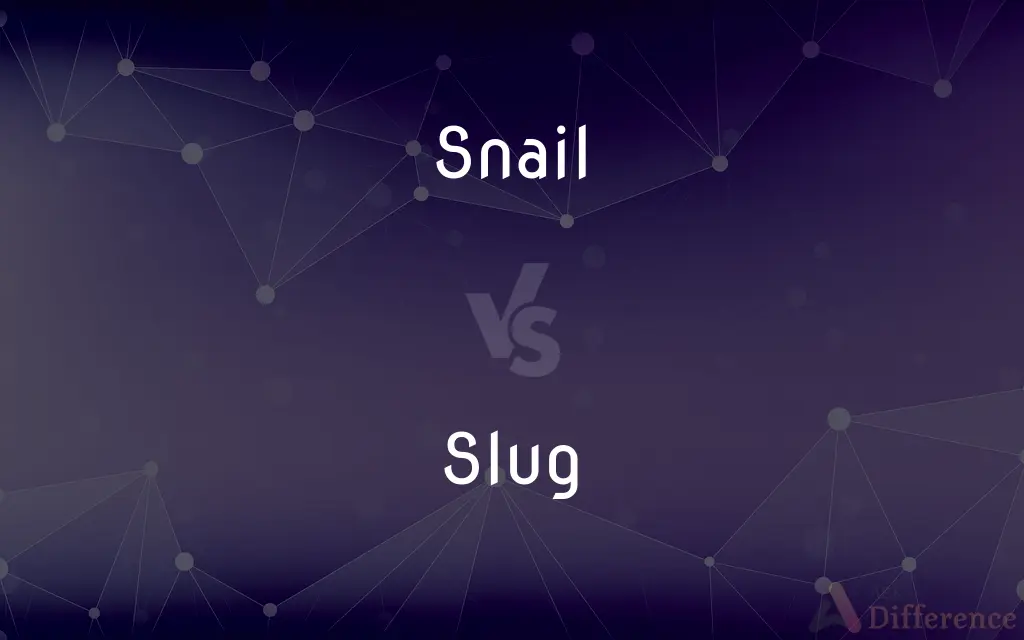Snail vs. Slug — What's the Difference?
By Tayyaba Rehman — Updated on October 7, 2023
A snail is a mollusk with a coiled shell, while a slug is similar but lacks a shell or has a very small internal one.

Difference Between Snail and Slug
Table of Contents
ADVERTISEMENT
Key Differences
Snails and slugs are fascinating creatures, both belonging to the class Gastropoda in the animal kingdom. A snail is easily recognizable by its coiled shell, which it carries on its back. This shell provides protection from predators and environmental conditions. The shell is made of calcium carbonate and grows with the snail over time, making it a permanent and integral part of the snail's body.
Conversely, a slug either entirely lacks this protective shell or possesses a small, internal vestigial shell that's not easily noticeable. This absence or reduction of the shell makes slugs appear more elongated and worm-like compared to snails. Due to the lack of a hard external shell, slugs have developed other mechanisms for defense and moisture retention, like producing a thick layer of mucus.
Both snails and slugs move using a muscular foot, leaving behind a slimy trail, which serves various purposes including aiding in movement and deterring predators. Their diet is quite similar, consisting mainly of decaying plant matter and fungi, but they can also be herbivores or even carnivores in some cases.
In essence, while snails and slugs share several similarities due to their close taxonomic relationship, the most prominent difference is the presence or absence of the shell. Their adaptability and diverse habitats, from gardens to forests, make them an intriguing study in the world of mollusks.
Comparison Chart
Physical Appearance
Has a coiled external shell
Lacks an external shell or has a small internal one
ADVERTISEMENT
Protection
Uses its shell for protection
Relies on mucus and camouflage
Movement
Uses a muscular foot and leaves a slimy trail
Uses a muscular foot and leaves a slimy trail
Diet
Mostly herbivores, but varies
Mostly herbivores, but varies
Habitats
Found in various habitats, often in moist areas
Found in various habitats, often in moist areas
Compare with Definitions
Snail
A slow-moving gastropod.
The snail inched its way up the leaf.
Slug
A shell-less or nearly shell-less gastropod.
A slug moved across the garden path during the night.
Snail
An invertebrate with a slimy trail.
Kids watched in fascination as the snail left a glistening trail.
Slug
A slow-moving, elongated mollusk.
The slug seemed to enjoy the fresh lettuce in the garden.
Snail
Can be terrestrial or aquatic.
The pond was home to several aquatic snails.
Slug
Often found in damp environments.
Slugs appeared in abundance in the basement after the flood.
Snail
Often found in moist environments.
She found a snail hiding under the wet log.
Slug
Can be pests in gardens due to their eating habits.
Gardeners often seek methods to deter slugs from their plants.
Snail
A snail is, in loose terms, a shelled gastropod. The name is most often applied to land snails, terrestrial pulmonate gastropod molluscs.
Slug
Slug, or land slug, is a common name for any apparently shell-less terrestrial gastropod mollusc. The word slug is also often used as part of the common name of any gastropod mollusc that has no shell, a very reduced shell, or only a small internal shell, particularly sea slugs and semislugs (this is in contrast to the common name snail, which applies to gastropods that have a coiled shell large enough that they can fully retract its soft parts into the shell).
Snail
Any of numerous aquatic or terrestrial gastropod mollusks that typically have a spirally coiled shell, retractile foot, and distinct head.
Slug
A round bullet larger than buckshot.
Snail
A slow-moving, lazy, or sluggish person.
Slug
A shot of liquor.
Snail
Any of very many animals (either hermaphroditic or nonhermaphroditic), of the class Gastropoda, having a coiled shell.
Slug
An amount of liquid, especially liquor, that is swallowed in one gulp; a swig.
Snail
A slow person; a sluggard.
Slug
A small metal disk for use in a vending or gambling machine, especially one used illegally.
Snail
(engineering) A spiral cam, or a flat piece of metal of spirally curved outline, used for giving motion to, or changing the position of, another part, as the hammer tail of a striking clock.
Slug
A lump of metal or glass prepared for further processing.
Snail
A tortoise or testudo; a movable roof or shed to protect besiegers.
Slug
A strip of type metal, less than type-high and thicker than a lead, used for spacing.
Snail
The pod of the snail clover.
Slug
A line of cast type in a single strip of metal.
Snail
(railroading) A locomotive with a prime mover but no traction motors, used to provide extra electrical power to another locomotive.
Slug
A compositor's type line of identifying marks or instructions, inserted temporarily in copy.
Snail
To move or travel very slowly.
Slug
(Physics) The British unit of mass that accelerates at the rate of one foot per second per second when acted on by a force of one pound on the surface of the Earth.
Snail
Any one of numerous species of terrestrial air-breathing gastropods belonging to the genus Helix and many allied genera of the family Helicidæ. They are abundant in nearly all parts of the world except the arctic regions, and feed almost entirely on vegetation; a land snail.
Slug
Any of various terrestrial gastropod mollusks having a slow-moving slimy elongated body with no shell or with a flat rudimentary shell on or under the skin, usually found in moist habitats.
Snail
Hence, a drone; a slow-moving person or thing.
Slug
A sea slug.
Snail
A spiral cam, or a flat piece of metal of spirally curved outline, used for giving motion to, or changing the position of, another part, as the hammer tail of a striking clock.
Slug
The smooth soft larva of certain insects, such as the sawfly.
Snail
A tortoise; in ancient warfare, a movable roof or shed to protect besiegers; a testudo.
They had also all manner of gynes [engines] . . . that needful is [in] taking or sieging of castle or of city, as snails, that was naught else but hollow pavises and targets, under the which men, when they fought, were heled [protected], . . . as the snail is in his house; therefore they cleped them snails.
Slug
A slimy mass of aggregated amoeboid cells that develops into the spore-bearing fruiting body of a cellular slime mold.
Snail
The pod of the sanil clover.
Slug
(Informal) A sluggard.
Snail
Freshwater or marine or terrestrial gastropod mollusk usually having an external enclosing spiral shell
Slug
A hard heavy blow, as with the fist or a baseball bat.
Snail
Edible terrestrial snail usually served in the shell with a sauce of melted butter and garlic
Slug
A commuter who slugs.
Snail
Gather snails;
We went snailing in the summer
Slug
(Printing) To add slugs to.
Snail
A mollusk with a spiral coiled shell.
The garden was full of snails after the rain.
Slug
(Informal) To drink rapidly or in large gulps
Slugged down a can of pop.
Slug
To strike heavily, especially with the fist or a bat.
Slug
To wait for or obtain a ride to work by standing at a roadside hoping to be picked up by a driver who needs another passenger to use the HOV lanes of a highway.
Slug
Any of many terrestrial pulmonate gastropod mollusks, having no (or only a rudimentary) shell.
Slug
(obsolete) A slow, lazy person; a sluggard.
Slug
A bullet or other projectile fired from a firearm; in modern usage, generally refers to a shotgun slug.
Slug
A solid block or piece of roughly shaped metal.
Slug
A counterfeit coin, especially one used to steal from vending machines.
Slug
A shot of a drink, usually alcoholic.
Slug
(journalism) A title, name or header, a catchline, a short phrase or title to indicate the content of a newspaper or magazine story for editing use.
Slug
The imperial (English) unit of mass that accelerates by 1 foot per second squared (1 ft/s²) when a force of one pound-force (lbf) is exerted on it.
Slug
A discrete mass of a material that moves as a unit, usually through another material.
Slug
A motile pseudoplasmodium formed by amoebae working together.
Slug
(railroading) An accessory to a diesel-electric locomotive, used to increase adhesive weight and allow full power to be applied at a lower speed. It has trucks with traction motors, but lacks a prime mover, being powered by electricity from the mother locomotive, and may or may not have a control cab.
Slug
(television editing) A black screen.
Slug
(metal typesetting) A piece of type metal imprinted by a linotype machine; also a black mark placed in the margin to indicate an error; also said in application to typewriters; type slug.
Slug
(regional) A stranger picked up as a passenger to enable legal use of high occupancy vehicle lanes.
Slug
A hitchhiking commuter.
Slug
(web design) The last part of a clean URL, the displayed resource name, similar to a filename.
Slug
(obsolete) A hindrance, an obstruction.
Slug
A ship that sails slowly.
Slug
To hit A hard blow, usually with the fist.
Slug
To drink quickly; to gulp; to down.
Slug
To take part in casual carpooling; to form ad hoc, informal carpools for commuting, essentially a variation of ride-share commuting and hitchhiking.
Slug
To become reduced in diameter, or changed in shape, by passing from a larger to a smaller part of the bore of the barrel.
Slug
To move slowly or sluggishly; to lie idle.
Slug
(transitive) To load with a slug or slugs.
To slug a gun
Slug
To make sluggish.
Slug
(transitive) To hit very hard, usually with the fist.
He insulted my mother, so I slugged him.
The fighter slugged his opponent into unconsciousness.
Slug
A drone; a slow, lazy fellow; a sluggard.
Slug
A hindrance; an obstruction.
Slug
Any one of numerous species of terrestrial pulmonate mollusks belonging to Limax and several related genera, in which the shell is either small and concealed in the mantle, or altogether wanting. They are closely allied to the land snails.
Slug
Any smooth, soft larva of a sawfly or moth which creeps like a mollusk; as, the pear slug; rose slug.
Slug
A ship that sails slowly.
His rendezvous for his fleet, and for all slugs to come to, should be between Calais and Dover.
Slug
An irregularly shaped piece of metal, used as a missile for a gun.
Slug
A thick strip of metal less than type high, and as long as the width of a column or a page, - used in spacing out pages and to separate display lines, etc.
Slug
To move slowly; to lie idle.
To slug in sloth and sensual delight.
Slug
To make sluggish.
Slug
To load with a slug or slugs; as, to slug a gun.
Slug
To strike heavily.
Slug
To become reduced in diameter, or changed in shape, by passing from a larger to a smaller part of the bore of the barrel; - said of a bullet when fired from a gun, pistol, or other firearm.
Slug
A projectile that is fired from a gun
Slug
An idle slothful person
Slug
Any of various terrestrial gastropods having an elongated slimy body and no external shell
Slug
Strike heavily, especially with the fist or a bat;
He slugged me so hard that I passed out
Slug
Be idle; exist in a changeless situation;
The old man sat and stagnated on his porch
He slugged in bed all morning
Slug
Known for its thick mucus secretion.
Touching the slug left a slimy residue on her fingers.
Common Curiosities
Do snails and slugs have the same diet?
Largely yes, but it can vary. Both can consume plant matter, fungi, and some can even be carnivorous.
Do all snails have shells?
All true snails have shells, but the size and prominence can vary.
Why do slugs produce mucus?
Slugs produce mucus for movement, protection, moisture retention, and defense against predators.
Are slugs just snails without shells?
Not exactly. While similar, slugs either lack a shell entirely or have a small, internal one.
Can both snails and slugs damage plants?
Yes, both can be pests in gardens as they feed on plants.
Are snails and slugs related?
Yes, both snails and slugs belong to the class Gastropoda.
Do snails and slugs have eyes?
Yes, they have tentacles on their heads, with larger ones typically having eye-like structures at the tips.
Can snails and slugs retract into their shells or bodies?
Snails can retract into their shells for protection, while slugs can contract their bodies.
Are there aquatic versions of snails and slugs?
Yes, there are aquatic snails and some sea slugs in marine environments.
How do snails and slugs reproduce?
Most snails and slugs are hermaphroditic, meaning they have both male and female reproductive organs.
How do snails grow their shells?
Snail shells are made of calcium carbonate and grow as the snail grows.
Do snails and slugs play a role in the ecosystem?
Absolutely, they help in decomposition, serve as food for various animals, and play roles in nutrient cycling.
Is the slime trail of snails and slugs the same?
Both produce a mucus trail, but the composition and purpose can vary.
Is it true that salt can harm snails and slugs?
Yes, salt can dehydrate and harm them, which is why it's sometimes used as a deterrent.
How can I naturally deter slugs from my garden?
Natural deterrents include diatomaceous earth, copper barriers, and certain plants like rosemary and thyme.
Share Your Discovery

Previous Comparison
Proposition vs. Support
Next Comparison
Absolute vs. RelativeAuthor Spotlight
Written by
Tayyaba RehmanTayyaba Rehman is a distinguished writer, currently serving as a primary contributor to askdifference.com. As a researcher in semantics and etymology, Tayyaba's passion for the complexity of languages and their distinctions has found a perfect home on the platform. Tayyaba delves into the intricacies of language, distinguishing between commonly confused words and phrases, thereby providing clarity for readers worldwide.
















































